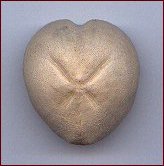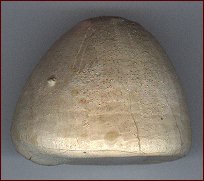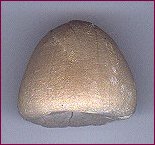 |
Grey Olltwit - Fossils and Dinosaurs |
 |
| Home | Fossil Facts | Dinosaurs | Fossil Finds | Contact | Links |
|
|
ECHINOID
ECHINOID
ECHINOID
ECHINOID
SERPULID More to be added. ECHINODERMS The echinoderms are a marine group known from the Cambrian Period. They have distinctive skeletons made up of interlocking plates or spines of lime. Forms found only in the Palaeozoic include the Edrioasteroids which were disc-shaped with a star-like pattern on the upper surface, and the Cystoids and Blastoids, which had tulip-shaped bodies attached to the sea-floor by stalks. Three more advanced groups of echinoderms first appeared in the Ordovician and can still be found today. The Crinoids, or Sea-lilies, usually had jointed stems, with which they attached themselves to the sea- floor or floating driftwood. This stem was surmounted by a 'head' of numerous fine, jointed 'arms'; the whole appearance being very flower-like. Isolated round or star shaped segments of the stems are common in many Palaeozoic and Mesozoic rocks. Crinoids are now fairly rare. Starfish are uncommon as fossils. They have five radiating 'arms' with rows of 'tube-feet' which enable them to move about the sea-floor, and, in some cases, prise open the shells of mollusc prey. The related brittlestars have long, delicate arms radiating from a central, disc shaped body. The sea-urchins, or Echinoids, are common fossils in, for example, the Cretaceous Chalk. They have compact bodies made up of interlocking plates from which protrude numerous spines. These spines have usually fallen off the fossils. Echinoids tend to be fairly small, usually under lOcm in diameter. Worms, or Serpulids, are known as fossils from the Cambrian period onwards. Generally their remains are rare because their bodies were so soft (like modern earthworms) but some, such as Proliserpula Proteus, above, lived in hard tubes that have been preserved as fossils. Sometimes these tubes are found attached to the shells of other creatures, e:g. echinoids, brachiopods or molluscs. Other are known by the burrows they made in sediment that has now turned into rock. There are many other modern groups of wormlike creatures (i.e. not true worms). Some of them, such as tapeworms, are parasitic. Most of these are not known as fossils.
Fossil Facts - What They Are - How They Are Formed - Where To Find Them Dinosaurs - Cetiosaurus - Compsognathus - Diplodocus - Edmontosaurus Euoplocephalus - Gallimimus - Giganotosaurus - Heterodontosaurus - Hypsilophodon Iguanodon - Parasaurolophus - Proceratosaurus - Protoceratops - Rebbachisaurus Stegoceras - Stegosaurus - Titanosaurus - Triceratops - Tyrannosaurus Rex (T Rex) - Velociraptor Fossil Finds - Cyprus - Folkestone, UK - Herne Bay, UK - Lake District, UK Norfolk, UK - Thanet, UK - Walton, UK Educational Software - Links - Contact Us
|
|





